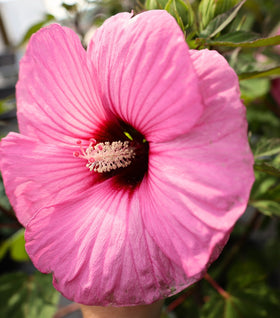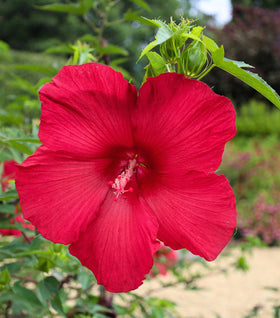Hardy Hibiscus Plants for Sale Online
Hardy Hibiscus plants are native plants that are beginning to find their homes in American gardens. The hardy garden hibiscus or rose mallows are sun-loving perennial plants known for their huge flowers that can be as large as dinner plants. This is why some gardeners call them Dinner Plate Hibiscus.
Perennial hibiscus plants are great options for wet areas of the garden and rain gardens, as they are indigenous to wet areas and can often be seen growing at the edges of ponds, bogs, and wetland areas. Perennial hibiscus tolerates average garden soil equally as well and can also be grown in containers. They make a vivid color statement when used as the centerpiece in mixed containers.
When you ask people about hibiscus plants, the first thing that comes to mind is the tender ones that are often grown in patio pots or indoors. Hardy hibiscus produces much larger flowers than tropical varieties. Hardy hibiscus plants flower in midsummer and are a favorite nectar source for butterflies and hummingbirds. They are fast growers and emerge from dormancy rather late in the spring, but there's no need to worry as they will quickly fill the role in the landscape as a colorful showpiece.
Growing Hardy Hibiscus in the Landscape
Hardy hibiscus plants will be the showpiece of your garden from summer through fall. Perennial hibiscus plants can be grown as far north as Zone 4 for some varieties. In the farther north areas, the hardy hibiscus will be one of the last plants in your garden to wake from their winter slumber.
We've heard from clients concerned that their hibiscus did not make it through the winter, only to hear back in a few days that the emerging shoot is now 8 inches tall. There's no need to worry about these stalwart and hardy perennials.
Where to Plant Hardy Hibiscus Plants in the Garden
Hardy Hibiscus plants love full sun and prefer moist, well-drained soil. Keeping hibiscus plants happy will result in larger flowers and lush foliage. Deadheading or removing the spent flowers will improve the plant's appearance and increase the re-blooming flowers.
Hibiscus plants blend well with other shorter plants that can be used to fill in the areas under this large plant. They remain upright, don't occupy much room at the base, and don't mind having plants around them. Peonies, Coneflowers, and Rudbeckia are good choices for companion planting.
Hardy Hibiscus plants are also very salt-tolerant. They can be planted near sea walls where the salt spray can be problematic. Hibiscus are also great candidates for planting near the road in areas with salt spread on the winter roads.
Pruning Hardy Hibiscus to Keep Them Compact
If you want to keep your perennial Hibiscus plants more compact, they can be pinched after they emerge in the spring. Pinch the shoots in half when they emerge from the ground and are about 10 inches tall. The pinch should be made just above a set of leaves; this improves branching. By doing this, the plant will yield more flowers and stay shorter.
If you are growing hardy hibiscus in containers, you can pinch them back 2 or 3 times before the End of June. Be careful to take no more than half of the stem and pinch just above a set of leaves. You will get fuller plants from multiple pinches. Pinching is not essential, and the plants will have fewer branches, but they will perform perfectly well.
Dead-heading Hardy Hibiscus Plants
Deadheading or removing the plant's spent flowers is easy and will help the plant continue to flower. Removing the old flowers also removes the developing seeds. Hardy Hibiscus can self-seed in the garden. This is generally not a huge problem unless the plants are being grown in a formal landscape. Generally speaking, if you're growing hibiscus in a wild area or rain garden, allowing them to self-seed is okay. Seedlings will not be true to name and, in most cases, won't resemble the parent. In our experience, most of the seedlings develop into red flowering plants. Birds adore the seeds and often visit the plant in the early winter to stock up on the remaining seeds.
Cutting Back Hardy Hibiscus Plants in the Winter
After the plants go dormant in the winter, they can be cut back to within a few inches of the ground. Hardy Hibiscus plants re-emerge from the crown or underground part of the plant. There's no benefit to allowing large portions of the stem to remain as the plant will not resprout on last year's stem. One thing to remember, though, is that leaving 12 inches of the stem can be a reminder that the plant is there. Since Hibiscus emerge from the ground so late, it is common for gardeners to forget they are there, so leaving the thickest part of the stem often reminds them.







